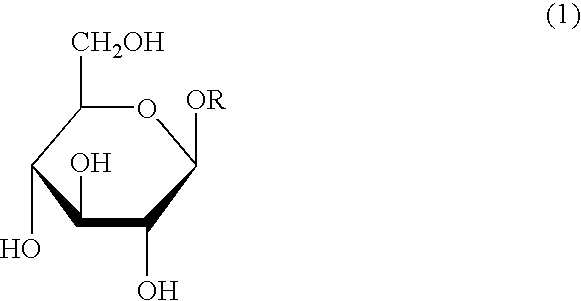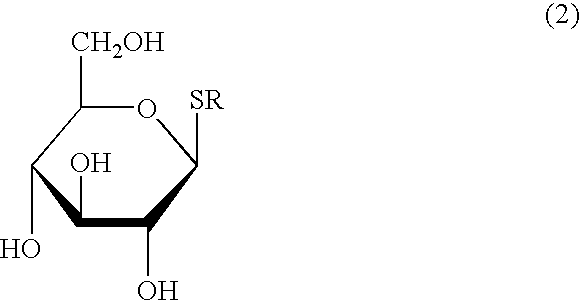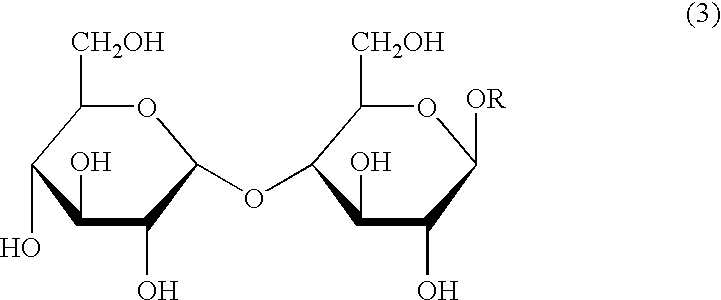Process for the reduction of endotoxins in a plasmid preparation using a carbohydrate non-ionic detergent with silica chromatography
a technology of carbohydrate non-ionic detergent and plasmid preparation, which is applied in the direction of microorganism lysis, organic chemistry, microorganisms, etc., can solve the problems of undesired side reactions, poor binding capacity of the separating materials generally used for plasmid dna, and long and tedious, so as to reduce endotoxin levels and reduce endotoxin levels. , the effect of simple and fas
- Summary
- Abstract
- Description
- Claims
- Application Information
AI Technical Summary
Benefits of technology
Problems solved by technology
Method used
Image
Examples
example 1
Purification of Endotoxin-free pBICEP-CMV-1-LacZ using n-octyl-β-D-thioglucopyranoside Detergent with Silica Chromatography
[0122]A flask containing LB medium and 100 μg / ml of ampicillin was inoculated with E. coli strain HB101 harboring pBICEP-CMV-1-LacZ. The culture was grown shaking at 250 RPM for 17 hours at 37° C. A 150 ml aliquot of the culture was harvested by centrifugation for each sample prepared. The bacterial pellets were thoroughly resuspended in 12 ml of Resuspension Solution. The cell suspensions were then subjected to a modified alkaline-SDS lysis by the addition of 12 ml of Lysis Solution. The lysates were neutralized with the addition of 12 ml of Neutralization Solution. This resulted in the formation of a white flocculent precipitate containing denatured proteins, lipids, SDS, chromosomal DNA, and other cell debris. The lysates were transferred to individual filtration units and incubated at room temperature for 5 minutes. The lysates were drawn through the filtrat...
example 2
Further Reduction in Endotoxin Levels by Using an Additional Wash Solution Containing n-octyl-β-D-thioglucopyranoside Detergent and Guanidine Hydrochloride
[0132]A flask containing LB medium and 100 μg / ml of ampicillin was inoculated with E. coli strain DH5α harboring pCMV-SPORT-βgal. Control samples were prepared, loaded onto the silica column, washed and eluted as described in Example 1. Additional samples were prepared and loaded onto the silica column as described in Example 1. The columns were then washed with 12 ml of 1% n-octyl-β-D-thioglucopyranoside in 1.6M guanidine hydrochloride. The columns were further washed with 12 ml of Wash Solution 1 and 12 ml of Wash Solution 2. The columns were dried and the plasmid was eluted as described in Example 1. Table No. 9 shows the reduced endotoxin levels obtained with the additional wash.
[0133]
TABLE NO. 9Results with additional wash.SamplePlasmid YieldEndotoxin Levels(2 replicates each)(ug)(EU / mg)Control84059Plus additional wash7804
example 3
Purification of pCMV-SPORT-βgal Using Various Non-Ionic Detergents with Silica Chromatography
[0134]A flask containing LB medium and 100 μg / ml of ampicillin was inoculated with E. coli strain DH5α harboring pCMV-SPORT-βgal. The plasmid was purified as in Example 1 with the detergents listed in Table No. 10 on a reduced scale (5%). All detergent solutions were made up in 8M guanidine hydrochloride and used as the Binding Solution. Table No. 10 shows the results indicating that only carbohydrate non-ionic detergents provide good plasmid yields along with low endotoxin levels.
[0135]
TABLE NO. 10Results with various detergents.AverageAveragePlasmidEndotoxinYieldLevelsDetergent ClassDetergent(ug)(EU / mg)No Detergent Control29>4500AlkylDetergent control2232thioglucoside5% n-octyl-β-D-1-thioglucopyranosideAlkyl glucoside2.5% n-octyl-β-D-37120glucopyranoside5% n-octyl-β-D-2926glucopyranosideAlkyl maltoside10% n-decyl-p-D-1658maltopyranosideAlkyl sulfate0.5% sodium dodecyl42*sulfate1.0% sodium ...
PUM
| Property | Measurement | Unit |
|---|---|---|
| molecular weight | aaaaa | aaaaa |
| size | aaaaa | aaaaa |
| pH | aaaaa | aaaaa |
Abstract
Description
Claims
Application Information
 Login to View More
Login to View More - R&D
- Intellectual Property
- Life Sciences
- Materials
- Tech Scout
- Unparalleled Data Quality
- Higher Quality Content
- 60% Fewer Hallucinations
Browse by: Latest US Patents, China's latest patents, Technical Efficacy Thesaurus, Application Domain, Technology Topic, Popular Technical Reports.
© 2025 PatSnap. All rights reserved.Legal|Privacy policy|Modern Slavery Act Transparency Statement|Sitemap|About US| Contact US: help@patsnap.com



